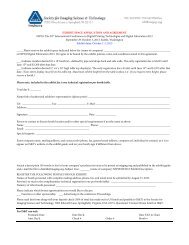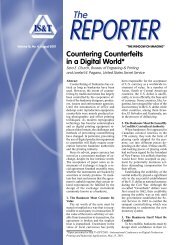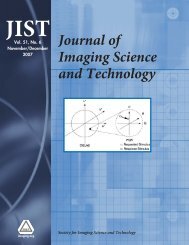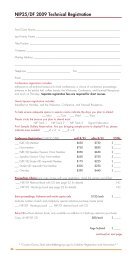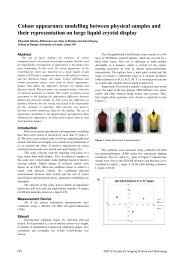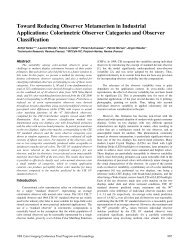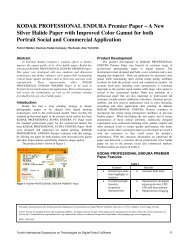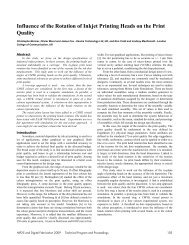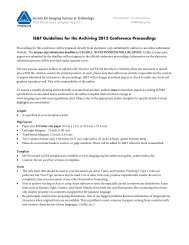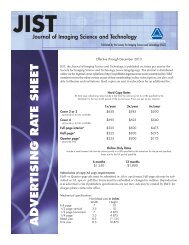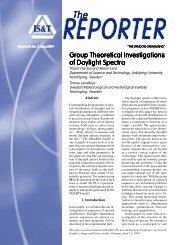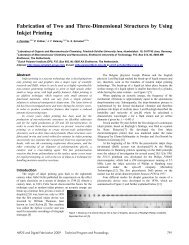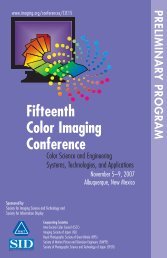JIST - Society for Imaging Science and Technology
JIST - Society for Imaging Science and Technology
JIST - Society for Imaging Science and Technology
You also want an ePaper? Increase the reach of your titles
YUMPU automatically turns print PDFs into web optimized ePapers that Google loves.
Chang <strong>and</strong> Chao: Preparation of microemulsion based disperse dye inks <strong>for</strong> thermal bubble ink jet printing<br />
Table I. Preparations <strong>and</strong> particle sizes of stabilized disperse dye dispersions dye content: 20%.<br />
EXPERIMENTAL<br />
Preparation of Dispersion of Disperse Dye<br />
Disperse dyes in the <strong>for</strong>m of presscake with high purity is a<br />
prerequisite in the ink <strong>for</strong>mulation to ensure an accurate<br />
reaction system unaffected by side products of the synthesized<br />
dye. The dyes applicable <strong>for</strong> ink jet ink should be exhibited<br />
with neutral color shade <strong>and</strong> demonstrated dyeing<br />
fastness. In the interest of our investigation, we selected the<br />
dyes resembling the process colors in commercial ink jet<br />
printing <strong>and</strong> analyzed the effects of different dyes on the ink<br />
<strong>for</strong>mulation. We selected C.I. Disperse Blue 60 (bright<br />
greenish blue, C.I. Constitution No. 61104, Widetex, Taiwan)<br />
<strong>for</strong> cyan by comparing to C.I. Disperse Blue 79 (dark reddish<br />
blue, C.I. Constitution No. 11345, Widetex, Taiwan),<br />
C.I. Disperse Red 60 (bright bluish red, C.I. Constitution<br />
No. 60756, Widetex, Taiwan) <strong>for</strong> magenta in contrast with<br />
C.I. Disperse Red 109 (bright yellowish red, C.I. Constitution<br />
No. 11192, Widetex, Taiwan), <strong>and</strong> C.I. Disperse Yellow<br />
77 (bright greenish yellow, C.I. Constitution No. 70150,<br />
Widetex, Taiwan) <strong>for</strong> yellow by analogy with C.I. Disperse<br />
Yellow 99 (bright greenish yellow, C.I. Constitution No.<br />
48420, Widetex, Taiwan). A combination of dispersants <strong>and</strong><br />
wetting agents applicable <strong>for</strong> disperse dyes in ink <strong>for</strong>mulation<br />
were divided into two systems of alkyl polynaphthalene<br />
<strong>for</strong>maldehyde sulfonate (D50, Pleasant <strong>and</strong> Best Chemical<br />
Co.) with the sodium salt of di-butyl naphthalene sulfonic<br />
acid (MT 830L, Pleasant <strong>and</strong> Best Chemical Co.), <strong>and</strong> maleic<br />
anhydride diisobutylene copolymer (PT 245L, Pleasant <strong>and</strong><br />
Best Chemical Co.) with Triton X-100 (PerkinElmer). Those<br />
disperse dye dispersions with particles of small size, i.e., precursors<br />
of microemulsion, were prepared by grinding with a<br />
planetary micromill (Pulverisette 7, Fritsch) where zirconium<br />
oxide grinding bowls <strong>and</strong> 0.5 mm beadswereadopted<br />
to effectively degrade particle size. Each sample was ground<br />
at 400 rpm <strong>for</strong> different times to obtain the derived particle<br />
size. Then, the dispersion liquid was filtered to remove contamination,<br />
such as particles derived from unwanted wear of<br />
the grinding elements, <strong>and</strong> finally stabilized with an<br />
antiprecipitating agent, NL428 (Jintex Co., Taiwan). Preferred<br />
dye dispersing methods are listed in Table I, where<br />
systems have been optimized to achieve extraordinary stability<br />
when particle size dropped below 200 nm. Although<br />
such preink obtained was well dispersed <strong>and</strong> stable, its physicochemical<br />
properties did not meet the dem<strong>and</strong>s of ink jet<br />
printing <strong>and</strong> immediately clogged printing nozzles because<br />
of high dye content (20%), high surface tension<br />
50–60 dyne/cm, <strong>and</strong> high viscosity 7–15 cps, whereas<br />
the relative values <strong>for</strong> thermal bubble ink jet inks were<br />
3–10% of dye content, 20–40 dyne/cm surface tension,<br />
414 J. <strong>Imaging</strong> Sci. Technol. 515/Sep.-Oct. 2007



